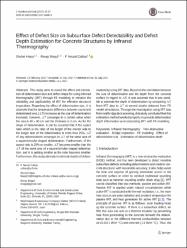Effect of Defect Size on Subsurface Defect Detectability and Defect Depth Estimation for Concrete Structures by Infrared Thermography
Abstract
This study aims to reveal the effect and correlation of delamination size and defect shape for using infrared thermography (IRT) through FE modeling to enhance the reliability and applicability of IRT for effective structural inspections. Regarding the effect of delamination size, it is observed that the temperature difference between sound and delaminated area (Delta T) increases as the size of delamination increases; however, Delta T converges to a certain value when the area is 40x40 cm and the thickness is 1 cm. As for the shape of delamination, it can be assumed that if the aspect ratio which is the ratio of the length of the shorter side to the longer side of the delamination is more than 25%, Delta T of any delaminations converges to Delta T of the same area of a square/circular-shaped delamination. Furthermore, if the aspect ratio is 25% or smaller, Delta T becomes smaller than the Delta T of the same area of a square/circular-shaped delamination, and it is getting smaller as the ratio becomes smaller. Furthermore, this study attempts to estimate depths of delaminations by using IRT data. Based on the correlation between the size of delamination and the depth from the concrete surface in regard to Delta T, it was assumed that it was possible to estimate the depth of delamination by comparing Delta T from IRT data to Delta T at several depths obtained from FE model simulations. Through the investigation using IRT data from real bridge deck scanning, this study concluded that this estimation method worked properly to provide delamination depth information by incorporating IRT with FE modeling.


















